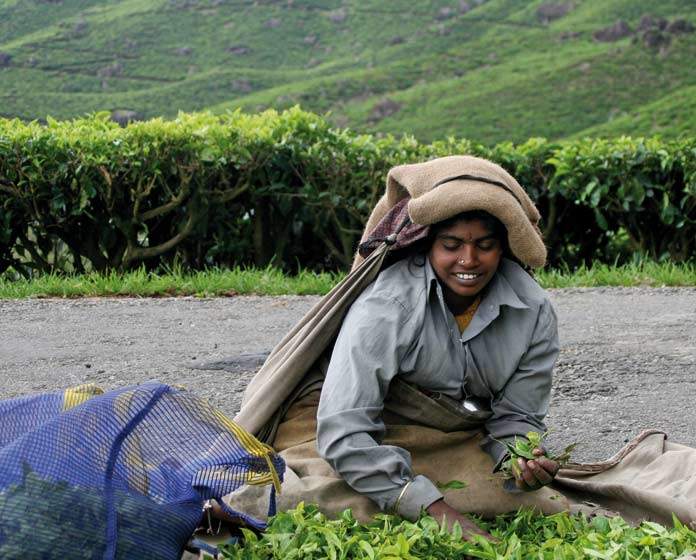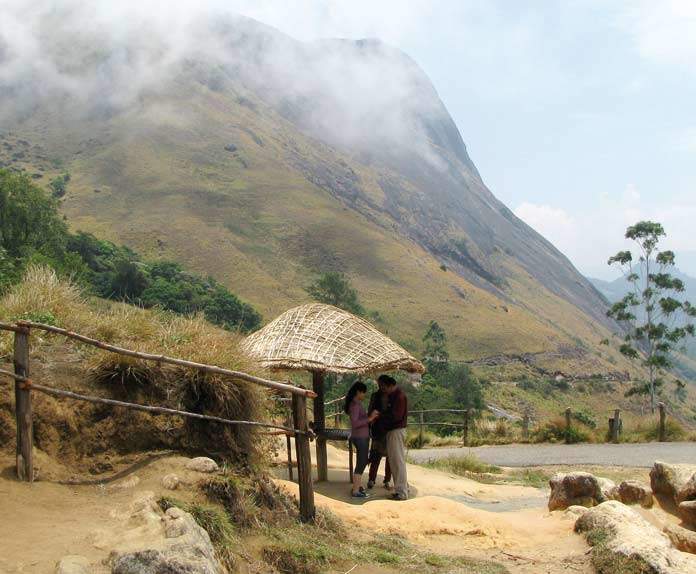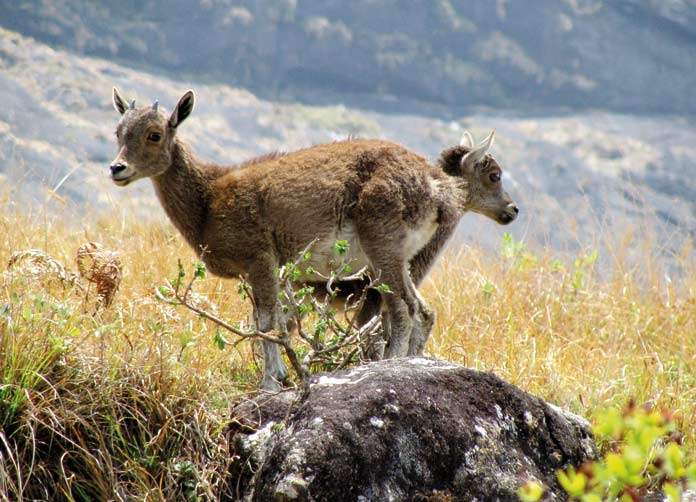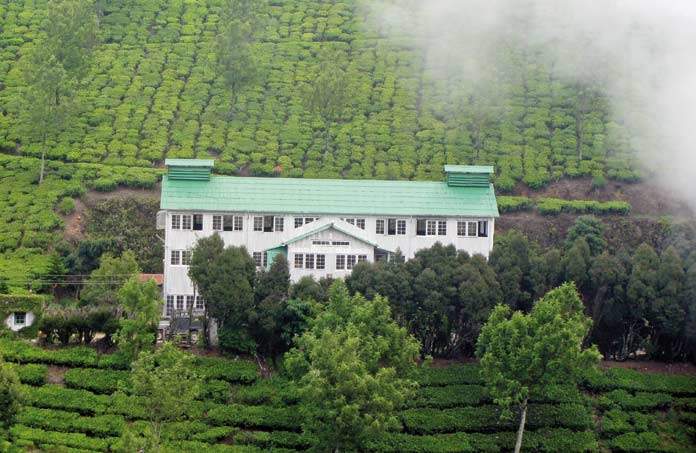Sloping hills, green, winding roads through rolling tea gardens, mists slowly enveloping the hills, silver oaks dancing in the wind, smell of cardamom in sprawling spice gardens and scenic resorts overlooking the valley; these are some of the scenes from Munnar, the breathtakingly beautiful hill station of Kerala. Wherever you go through the winding roads, you will find rolling grasslands and velvet beds of tea gardens all around you. Recently trimmed patches alongside brown cropped slopes and freshly grown tea, make Munnar the Eden of tea gardens. I’m not exaggerating; you really won’t find a greater variety of tea gardens elsewhere in India.
But that’s not all, Munnar also has lots of other things to offer—the Neelakurunji flower [the flower that lights up its forests once in 12 years], the Nilgiri Tahr [a rare breed of mountain goat that is found only in Munnar] and the Anamudi [the highest peak in South India].
Munnar derives its name from the Tamil words munu [three] and aaru [river]. The town is situated at the confluence of Mudrapuzha, Nallathani and Kundala rivers. It is located near the Tamil Nadu border and is close to both Coimbatore and Kochi, making it a preferred weekend spot for those residing there. But its beauty lures people from far and beyond—it’s also a popular destination of foreign tourists coming to India. It used to be the favourite summer resort of the English, when the British ruled India. And why not? The town and its surroundings vary in height from 1700m – 2700m above sea level and offer stunning views of hills and valleys. It has a salubrious climate round the year, which makes it a pleasurable place to spend your vacation. Even in summer, the temperature varies from 8 degrees – 16 degrees Celsius.
 In summer, the sudden showers turn its tea gardens into magical carpets and bestow an ethereal look to the landscape. No wonder many good resorts have cropped up in the area. A four or five night stay in these resorts can give you everything from recreational activities and tours to ayurvedic massages and treks—a total rejuvenation package. We booked ourselves into a resort near a tea garden. And as far as the eye could see, there was mist and miles of tea gardens. The main town is a little congested though.
In summer, the sudden showers turn its tea gardens into magical carpets and bestow an ethereal look to the landscape. No wonder many good resorts have cropped up in the area. A four or five night stay in these resorts can give you everything from recreational activities and tours to ayurvedic massages and treks—a total rejuvenation package. We booked ourselves into a resort near a tea garden. And as far as the eye could see, there was mist and miles of tea gardens. The main town is a little congested though.
So, if you want to live amidst nature, go a little farther to Chinnakanal. The pristine beauty of the hill station comes alive with mountains around and valleys below decorated with lakes and tea gardens. And it is in this place that most of the holiday homes, guest houses and hotels are set up.
There are lots of sights to see and explore in Munnar. Tours are arranged by the resorts. However, one can also hire a cab from outside. We hired one for four days and soaked in the scenes of Munnar at leisure. On the first day, we went around Munnar. We saw the Gap and Lockhart view points.
Here, you get tender coconuts, roasted corn, fresh carrots, cucumbers and hats. On the way, you can see the varied hues of green and grasslands. Streams flowing in between hill crevices greet you from time to time. During monsoon, they become full water falls, with frothy white water gushing down in force. Lakkom and Periyakanal are two falls worth visiting.
The Mattupetty Lake is a major crowd puller. Located 13km from Munnar, at a height of 1700m above sea level, it has a boating station where you can get pedal, motor or speed boats. As you cross the lake in a boat, you’ll pass thick eucalyptus plantations, pines and a variety of trees, cattle grazing on even land, the lush Shola forest and the dam. There are numerous lakeside shops that sell honey, home-made chocolates, shawls, caps and Kerala handicraft.
The Echo Point, a few kilometres from the dam, also offers panoramic views along with horse rides. The flower garden, on the way back, is a treasure house where you’ll find rare flowers like the Mother of Thousands along with common ones like the rose. Red, white, yellow and violet flowers in different sizes are displayed in hanging pots and steps, there is also a great variety of plants, ferns and cacti in every shade of green. It’s an eclectic mixture of beautiful creations of nature.
 On the second day, we headed to the Eravikulam National Park, 15km from Munnar. High up on Rajamalai [King of hills], this national park, spread out on 97sq km, is home to the rare Nilgiri Tahr, a variety of butterflies, birds and trees. The car goes up to a certain point, after which you have to board a bus that takes you to the start of the National Park. From there, you hike your way up. It is a steep climb that took us the better part of an hour. But once we reached there [though panting], we were well rewarded with a close view of the Nilgiri Tahrs that roam around the forest freely unmindful of the curious onlookers.
On the second day, we headed to the Eravikulam National Park, 15km from Munnar. High up on Rajamalai [King of hills], this national park, spread out on 97sq km, is home to the rare Nilgiri Tahr, a variety of butterflies, birds and trees. The car goes up to a certain point, after which you have to board a bus that takes you to the start of the National Park. From there, you hike your way up. It is a steep climb that took us the better part of an hour. But once we reached there [though panting], we were well rewarded with a close view of the Nilgiri Tahrs that roam around the forest freely unmindful of the curious onlookers.
 Nilgiri Tahr is a mountain goat that resembles both a goat and a deer. As you climb up the forested hill, you will find Tahrs on stone cliffs walking or sitting perched behind a bush. Sometimes they come down and walk across the road searching for food. Herbivores, they feed on leaves and shrubs. Tourists get excited spotting these rare animals that are declared endangered and wait to focus their camera lenses on the Tahrs for the perfect picture.
Nilgiri Tahr is a mountain goat that resembles both a goat and a deer. As you climb up the forested hill, you will find Tahrs on stone cliffs walking or sitting perched behind a bush. Sometimes they come down and walk across the road searching for food. Herbivores, they feed on leaves and shrubs. Tourists get excited spotting these rare animals that are declared endangered and wait to focus their camera lenses on the Tahrs for the perfect picture.
As you trek the hill, you will also find wild shrubs, tall trees, the shoal grasslands and peaks that make the National Park an ideal place to explore and shoot pictures. After a hard trek and climb down, you can drop in at the restaurant for cool drinks and a hot cup of instant noodles. On your way back, the driver stops the bus to point at the Anamudi, the highest peak in Southern India.
A tea factory is usually the last stop on the day trip. The guide takes you around the factory after offering you a stimulating cup of CTC [curled, torn and crushed] tea. The tour begins with a visit to the storing area, where you get to see how the curling, tearing and crushing of tea leaves is done before drying and packing them. You can buy the tea you like at a discounted rate at the sales outlet attached to the factory. You will also be shown a short film on tea making process that usually sums up the tour.
 For us, each day in Munnar sprung a fresh surprise. On the third day of our tour, we visited Kolukkumalai, the highest tea gardens and factory. Kolukkumalai is in Tamil Nadu, near the Kerala border. It is an hour’s drive through narrow tricky roads. The journey shakes you up, but the surrounding exotic scenery compensates for the rough uphill drive. Miles of tea gardens, semi-circular hills tapering down in steps with bordered roads and designer patches—as if an artist has created a masterpiece out of the nature around. And when you reach the top, you feel like you are in heaven—it’s a mesmerising sight to see the mist slowly enveloping the surrounding hills and homes. A visit to the oldest tea factory enlightens you on the natural method of cultivating tea.
For us, each day in Munnar sprung a fresh surprise. On the third day of our tour, we visited Kolukkumalai, the highest tea gardens and factory. Kolukkumalai is in Tamil Nadu, near the Kerala border. It is an hour’s drive through narrow tricky roads. The journey shakes you up, but the surrounding exotic scenery compensates for the rough uphill drive. Miles of tea gardens, semi-circular hills tapering down in steps with bordered roads and designer patches—as if an artist has created a masterpiece out of the nature around. And when you reach the top, you feel like you are in heaven—it’s a mesmerising sight to see the mist slowly enveloping the surrounding hills and homes. A visit to the oldest tea factory enlightens you on the natural method of cultivating tea.
We reserved the last day for the spice garden tour. This time, we travelled down instead of up, through cardamom orchards, eucalyptus groves and streams. We stopped to walk to the Anayirangal dam and view the beautiful lake from above. Unending tea gardens were around us this time too. One can never get tired of shooting pictures of the scenic gardens and the roads cutting through the estates. The hues and shapes of the tea gardens astound you with their variety.
Our driver stopped near a spice shop. From here, a guide gave us a tour of the five-acre spice garden. We walked through the cardamom orchards that occupied more than half of the sprawling spice garden. Our guide explained how long it took for them to ripen before they are plucked and dried. We passed by turmeric, ginger, coconut, black pepper, cloves, banyan, Neelakurunji, rudraksh, bamboo and many more trees and our guide once again explained the life and nature of the trees and their products. A few guests even climbed up a tree-top view point to get photographed. We left with a wonderful aroma of the spices in our minds. We also bought some spices from the shop before bidding goodbye to our guide.
Our trip had come to an end and it was time to leave. As we left the resort right after sunrise, the morning mists were still over the hills. The sun’s rays had covered the surroundings to provide a completely different picture. I captured a few in my camera. The curving roads through the tea gardens this time led us out
 Spot an error in this article? A typo maybe? Or an incorrect source? Let us know!
Spot an error in this article? A typo maybe? Or an incorrect source? Let us know!

Hi! I’m going to be writing about spice gardens on my blog this Sunday and wonder if I may use your picture of the hill of spices (with a link to this blog post). Would you approve of that? Thanks for considering!